曼昆《经济学原理》名词解释归纳
微观经济学原理(第七版)-曼昆-名词解释(带英文)
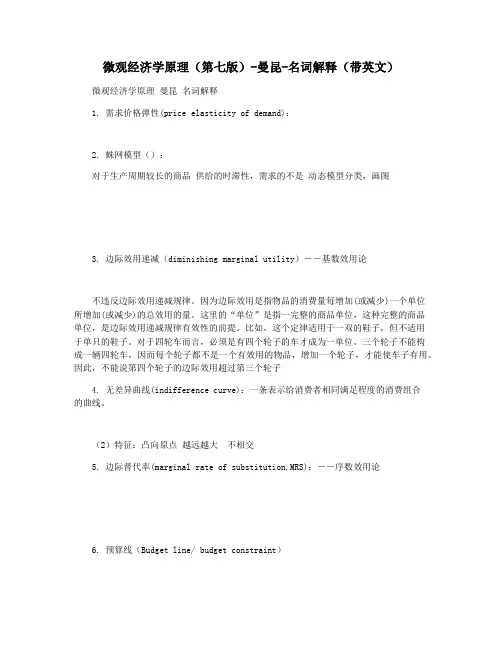
微观经济学原理(第七版)-曼昆-名词解释(带英文)微观经济学原理曼昆名词解释1. 需求价格弹性(price elasticity of demand):2. 蛛网模型():对于生产周期较长的商品供给的时滞性,需求的不是动态模型分类,画图3. 边际效用递减(diminishing marginal utility)――基数效用论不违反边际效用递减规律。
因为边际效用是指物品的消费量每增加(或减少)一个单位所增加(或减少)的总效用的量。
这里的“单位”是指一完整的商品单位,这种完整的商品单位,是边际效用递减规律有效性的前提。
比如,这个定律适用于一双的鞋子,但不适用于单只的鞋子。
对于四轮车而言,必须是有四个轮子的车才成为一单位。
三个轮子不能构成一辆四轮车,因而每个轮子都不是一个有效用的物品,增加一个轮子,才能使车子有用。
因此,不能说第四个轮子的边际效用超过第三个轮子4. 无差异曲线(indifference curve):一条表示给消费者相同满足程度的消费组合的曲线。
(2)特征:凸向原点越远越大不相交5. 边际替代率(marginal rate of substitution.MRS):――序数效用论6. 预算线(Budget line/ budget constraint)7. 吉芬物品(Giffen good):价格上升引起需求量增加的物品。
8. 柯布道格拉斯生产函数稀缺性(scarcity):社会资源的有限性。
经济学(economics):研究社会如何管理自己的稀缺资源。
效率(efficiency):社会能从其稀缺资源中得到最多东西的特性。
平等(equality):经济成果在社会成员中公平分配的特性。
机会成本(opportunity cost):为了得到某种东西所必须放弃的东西。
理性人(rational people):系统而有目的地尽最大努力实现起目标的人。
边际变动(marginal change):对行动计划微小的增量调整。
曼昆经济学原理中文版第六版术语表
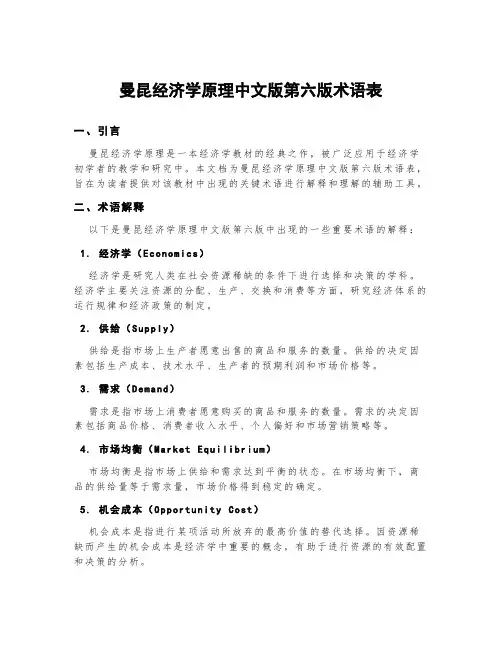
曼昆经济学原理中文版第六版术语表一、引言曼昆经济学原理是一本经济学教材的经典之作,被广泛应用于经济学初学者的教学和研究中。
本文档为曼昆经济学原理中文版第六版术语表,旨在为读者提供对该教材中出现的关键术语进行解释和理解的辅助工具。
二、术语解释以下是曼昆经济学原理中文版第六版中出现的一些重要术语的解释:1.经济学(E c o n o mi c s)经济学是研究人类在社会资源稀缺的条件下进行选择和决策的学科。
经济学主要关注资源的分配、生产、交换和消费等方面,研究经济体系的运行规律和经济政策的制定。
2.供给(S u p p l y)供给是指市场上生产者愿意出售的商品和服务的数量。
供给的决定因素包括生产成本、技术水平、生产者的预期利润和市场价格等。
3.需求(D e m a n d)需求是指市场上消费者愿意购买的商品和服务的数量。
需求的决定因素包括商品价格、消费者收入水平、个人偏好和市场营销策略等。
4.市场均衡(M a r ke t E q u i l i b r i u m)市场均衡是指市场上供给和需求达到平衡的状态。
在市场均衡下,商品的供给量等于需求量,市场价格得到稳定的确定。
5.机会成本(O p p or t u n i t y C o s t)机会成本是指进行某项活动所放弃的最高价值的替代选择。
因资源稀缺而产生的机会成本是经济学中重要的概念,有助于进行资源的有效配置和决策的分析。
6.边际效应(M a r gi n a l E f f e c t s)边际效应是指对某项决策增加或减少一单位量时所产生的影响。
边际效应可以帮助经济学家和决策者计算出最佳的决策方案。
7.产权(P r o p e r ty R i g h t s)产权是指一项资源的所有权和控制权,包括土地、房屋、知识产权等。
产权保护是市场经济顺利运行的基础,有助于激励个体创造财富和进行经济交换。
8.外部性(E x t e r na l i t y)外部性是指市场交易对除交易双方以外的第三方造成的影响。
曼昆《经济学原理》名词解释(整理版)
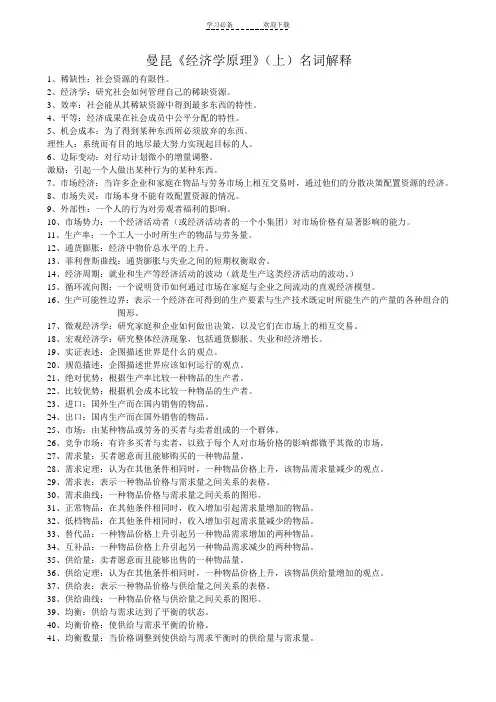
曼昆《经济学原理》(上)名词解释1、稀缺性:社会资源的有限性。
2、经济学:研究社会如何管理自己的稀缺资源。
3、效率:社会能从其稀缺资源中得到最多东西的特性。
4、平等:经济成果在社会成员中公平分配的特性。
5、机会成本:为了得到某种东西所必须放弃的东西。
理性人:系统而有目的地尽最大努力实现起目标的人。
6、边际变动:对行动计划微小的增量调整。
激励:引起一个人做出某种行为的某种东西。
7、市场经济:当许多企业和家庭在物品与劳务市场上相互交易时,通过他们的分散决策配置资源的经济。
8、市场失灵:市场本身不能有效配置资源的情况。
9、外部性:一个人的行为对旁观者福利的影响。
10、市场势力:一个经济活动者(或经济活动者的一个小集团)对市场价格有显著影响的能力。
11、生产率:一个工人一小时所生产的物品与劳务量。
12、通货膨胀:经济中物价总水平的上升。
13、菲利普斯曲线:通货膨胀与失业之间的短期权衡取舍。
14、经济周期:就业和生产等经济活动的波动(就是生产这类经济活动的波动。
)15、循环流向图:一个说明货币如何通过市场在家庭与企业之间流动的直观经济模型。
16、生产可能性边界:表示一个经济在可得到的生产要素与生产技术既定时所能生产的产量的各种组合的图形。
17、微观经济学:研究家庭和企业如何做出决策,以及它们在市场上的相互交易。
18、宏观经济学:研究整体经济现象,包括通货膨胀、失业和经济增长。
19、实证表述:企图描述世界是什么的观点。
20、规范描述:企图描述世界应该如何运行的观点。
21、绝对优势:根据生产率比较一种物品的生产者。
22、比较优势:根据机会成本比较一种物品的生产者。
23、进口:国外生产而在国内销售的物品。
24、出口:国内生产而在国外销售的物品。
25、市场:由某种物品或劳务的买者与卖者组成的一个群体。
26、竞争市场:有许多买者与卖者,以致于每个人对市场价格的影响都微乎其微的市场。
27、需求量:买者愿意而且能够购买的一种物品量。
曼昆微观经济学名词解释归纳
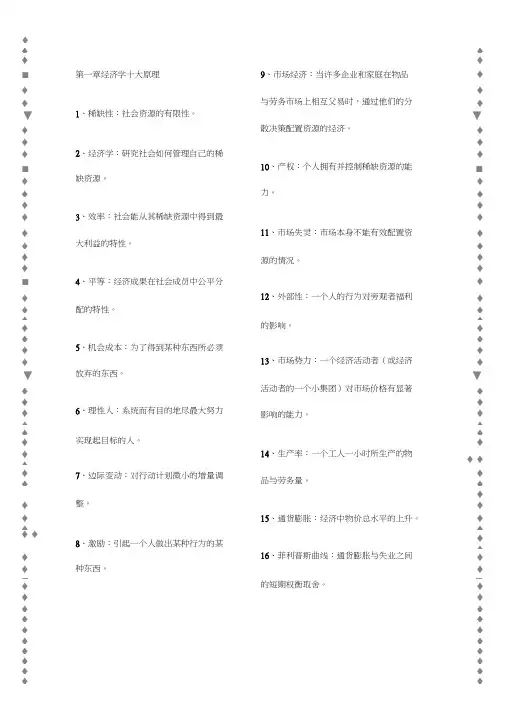
♦ ♦ ♦♦♦ ■ ♦ 第一章经济学十大原理9、市场经济:当许多企业和家庭在物品 ♦ ♦ ♦♦ ♦ ▲与劳务市场上相互父易时,通过他们的分♦ ▼■ 1、稀缺性:社会资源的有限性。
▼ ■ ♦ 散决策配置资源的经济。
♦♦♦ ♦ ▲ 2、经济学:研究社会如何管理自己的稀♦ A ■10、产权:个人拥有并控制稀缺资源的能■♦ 缺资源。
♦ ♦力。
♦ ♦♦ ♦ ♦ 3、效率:社会能从其稀缺资源中得到最♦ ■ ♦11、市场失灵:市场本身不能有效配置资♦ ♦ 大利益的特性。
♦ ♦ ♦ ▲源的情况。
♦ ♦ ■ ♦ 4、平等:经济成果在社会成员中公平分♦ ♦ ♦12、外部性:一个人的行为对旁观者福利♦ ♦ 配的特性。
♦ ♦♦ ♦ 的影响。
♦ ♦♦ ♦ 5、机会成本:为了得到某种东西所必须♦ ♦ ▲13、市场势力:一个经济活动者(或经济♦ ▲ ▼♦ 放弃的东西。
▼♦ ♦活动者的一个小集团)对市场价格有显著♦ ♦♦ ♦ ♦ 6、理性人:系统而有目的地尽最大努力影响的能力。
♦ ♦ ♦♦ ♦ 实现起目标的人。
♦ ♦ ♦14、生产率:一个工人一小时所生产的物♦ ♦ ♦ ♦7、边际变动:对行动计划微小的增量调品与劳务量。
♦ ♦♦ ♦ 整。
♦ ♦ ♦15、通货膨胀:经济中物价总水平的上升。
♦ ♦ ♦ ♦ 8、激励:引起一个人做出某种行为的某♦ ♦ ♦16、菲利普斯曲线:通货膨胀与失业之间♦ ♦ 种东西。
♦ ■■ ♦ 的短期权衡取舍。
♦ ♦♦ ♦♦ ♦♦ ♦♦ ♦♦ ♦♦ ♦♦ ♦♦ ♦♦♦♦ ♦ ♦♦♦ ■ ♦ 17、经济周期:就业和生产等经济活动的♦ ♦ ♦♦ ♦ ♦ ♦ ♦ ♦ ♦ 波动。
第3章相互依存性与贸易的好处♦ ♦ ♦ ♦ ♦ ♦ 1、绝对优势:根据生产率在一种物品的 ♦♦ ♦ ♦ 第2章像经济学家一样思考生产者之间的比较。
♦ ♦ ♦♦ ♦♦ ♦ 1、循环流向图:一个说明货币如何通过2、比较优势:根据机会成本在一种物品 ♦ ■ ♦♦ ♦ 市场在家庭与企业之间流动的直观经济的生产者之间的比较。
微观经济学原理第七版曼昆名词解释带英文
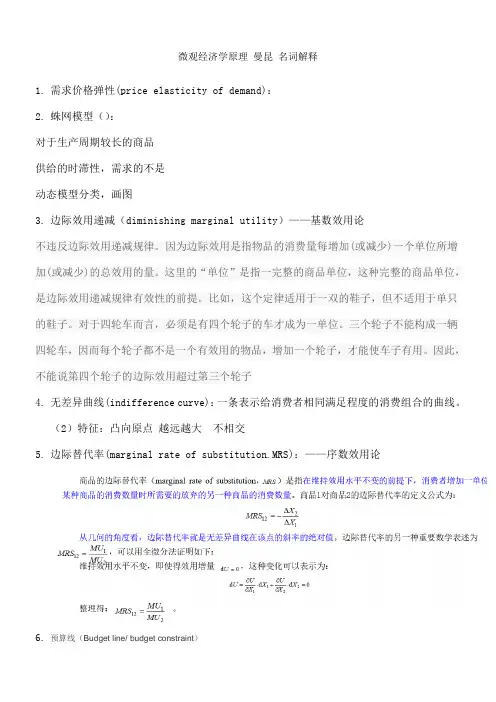
微观经济学原理曼昆名词解释1.需求价格弹性(price elasticity of demand):2.蛛网模型():对于生产周期较长的商品供给的时滞性,需求的不是动态模型分类,画图3.边际效用递减(diminishing marginal utility)——基数效用论不违反边际效用递减规律。
因为边际效用是指物品的消费量每增加(或减少)一个单位所增加(或减少)的总效用的量。
这里的“单位”是指一完整的商品单位,这种完整的商品单位,是边际效用递减规律有效性的前提。
比如,这个定律适用于一双的鞋子,但不适用于单只的鞋子。
对于四轮车而言,必须是有四个轮子的车才成为一单位。
三个轮子不能构成一辆四轮车,因而每个轮子都不是一个有效用的物品,增加一个轮子,才能使车子有用。
因此,不能说第四个轮子的边际效用超过第三个轮子4.无差异曲线(indifference curve):一条表示给消费者相同满足程度的消费组合的曲线。
(2)特征:凸向原点越远越大不相交5.边际替代率(marginal rate of substitution.MRS):——序数效用论6.预算线(Budget line/ budget constraint)7.吉芬物品(Giffen good):价格上升引起需求量增加的物品。
8.柯布道格拉斯生产函数稀缺性(scarcity):社会资源的有限性。
经济学(economics):研究社会如何管理自己的稀缺资源。
效率(efficiency):社会能从其稀缺资源中得到最多东西的特性。
平等(equality):经济成果在社会成员中公平分配的特性。
机会成本(opportunity cost):为了得到某种东西所必须放弃的东西。
理性人(rational people):系统而有目的地尽最大努力实现起目标的人。
边际变动(marginal change):对行动计划微小的增量调整。
激励(incentive):引起一个人做出某种行为的某种东西。
曼昆经济学原理第四版名词解释
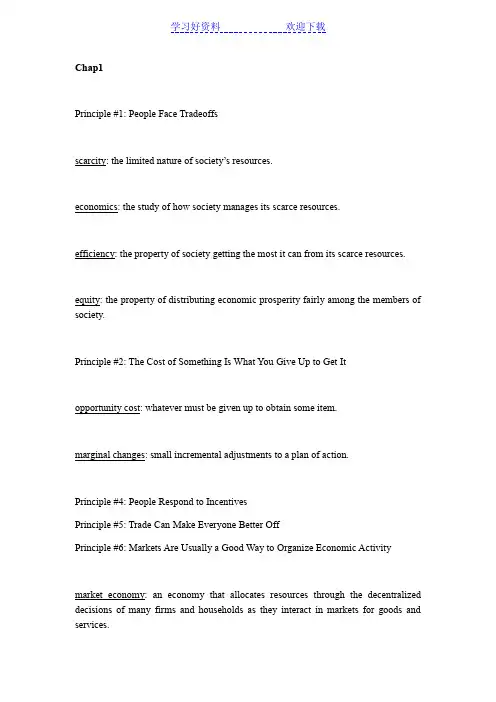
Chap1Principle #1: People Face Tradeoffsscarcity: the limited nature of society’s resources.economics: the study of how society manages its scarce resources.efficiency: the property of society getting the most it can from its scarce resources.equity: the property of distributing economic prosperity fairly among the members of society.Principle #2: The Cost of Something Is What You Give Up to Get Itopportunity cost: whatever must be given up to obtain some item.marginal changes: small incremental adjustments to a plan of action.Principle #4: People Respond to IncentivesPrinciple #5: Trade Can Make Everyone Better OffPrinciple #6: Markets Are Usually a Good Way to Organize Economic Activitymarket economy: an economy that allocates resources through the decentralized decisions of many firms and households as they interact in markets for goods and services.Principle #7: Governments Can Sometimes Improve Market Outcomesmarket failure: a situation in which a market left on its own fails to allocate resources efficiently.externality: the impact of one person’s actions on the well-being of a bystander.market power: the ability of a single economic actor (or small group of actors) to have a substantial influence on market prices.Principle #8: A Country’s Standard of Living Depends on Its Ability to Produce Goods and Servicesproductivity: the quantity of goods and services produced from each hour of a worker’s time.Principle #9: Prices Rise When the Government Prints Too Much Moneyinflation: an increase in the overall level of prices in the economy.Principle #10: Society Faces a Short-Run Tradeoff between Inflation and UnemploymentChap3absolute advantage: the comparison among producers of a good according to their productivity.opportunity cost: whatever must be given up to obtain some item.comparative advantage: the comparison among producers of a good according to their opportunity cost.imports: goods produced abroad and sold domestically.exports: goods produced domestically and sold abroadChap4market: a group of buyers and sellers of a particular good or service.competitive market: a market in which there are many buyers and many sellers so that each has a negligible impact on the market price.quantity demanded: the amount of a good that buyers are willing and able to purchase.law of demand: the claim that, other things equal, the quantity demanded of a good falls when the price of the good rises.demand schedule: a table that shows the relationship between the price of a good and the quantity demanded.demand schedule: a table that shows the relationship between the price of a good and the quantity demanded.demand curve: a graph of the relationship between the price of a good and the quantity demanded.normal good: a good for which, other things equal, an increase in income leads to an increase in demand.inferior good: a good for which, other things equal, an increase in income leads to a decrease in demand.substitutes: two goods for which an increase in the price of one good leads to an increase in the demand for the other.complements: two goods for which an increase in the price of one good leads to a decrease in the demand for the other.quantity supplied: the amount of a good that sellers are willing and able to sell.law of supply: the claim that, other things equal, the quantity supplied of a good rises when the price of the good rises.supply schedule: a table that shows the relationship between the price of a good andthequantity supplied.supply curve: a graph of the relationship between the price of a good and the quantity supplied.equilibrium: a situation in which the price has reached the level where quantity supplied equals quantity demanded.equilibrium price: the price that balances quantity supplied and quantity demanded.equilibrium quantity: the quantity supplied and the quantity demanded at the equilibrium price.surplus: a situation in which quantity supplied is greater than quantity demanded.shortage: a situation in which quantity demanded is greater than quantity supplied.law of supply and demand: the claim that the price of any good adjusts to bring the supply and demand for that good into balance.5elasticity: a measure of the responsiveness of quantity demanded or quantity supplied to one of its determinants.price elasticity of demand: a measure of how much the quantity demanded of a good responds to a change in the price of that good, computed as the percentage change in quantity demanded divided by the percentage change in price.total revenue: the amount paid by buyers and received by sellers of a good, computedas theprice of the good times the quantity sold.income elasticity of demand: a measure of how much the quantity demanded of a good responds to a change in consumers’ income, computed as the percentage change in quantity demanded divided by the percentage change in income.price elasticity of supply: a measure of how much the quantity supplied of a good responds to a change in the price of that good, computed as the percentage change in quantity supplied divided by the percentage change in price.6price ceiling: a legal maximum on the price at which a good can be sold.price floor: a legal minimum on the price at which a good can be sold.tax incidence: the manner in which the burden of a tax is shared among participants in a market.7welfare economics: the study of how the allocation of resources affects economic well-being.willingness to pay: the maximum amount that a buyer will pay for a good.consumer surplus: a buyer’s willingness to pay minus the amount the buyer actually pays.cost: the value of everything a seller must give up to produce a good.efficiency: the property of a resource allocation of maximizing the total surplus received by all members of society.equity: the fairness of the distribution of well-being among the members of society.8deadweight loss: the fall in total surplus that results from a market distortion, such as a tax.9world price: the price of a good that prevails in the world market for that good. tariff: a tax on goods produced abroad and sold domestically.import quota: a limit on the quantity of a good that can be produced abroad and sold domestically.10externality: the uncompensated impact of one person’s actions on the well-being of abystander.internalizing an externality: altering incentives so that people take account of the external effects of their actions.coase theorem: the proposition that if private parties can bargain without cost over the allocation of resources, they can solve the problem of externalities on their own.transaction costs: the costs that parties incur in the process of agreeing and following through on a bargain.Pigouvian tax: a tax enacted to correct the effects of a negative externality.11excludability: the property of a good whereby a person can be prevented from using it.rivalry: the property of a good whereby one person’s use diminishes other people’s use.private goods: goods that are both excludable and rival.public goods: goods that are neither excludable nor rival.common resources: goods that are rival but not excludable.free rider: a person who receives the benefit of a good but avoids paying for it.cost-benefit analysis: a study that compares the costs and benefits to society of providing a public good.tragedy of the commons: a parable that illustrates why common resources get used more than is desirable from the standpoint of society as a whole.13total revenue: the amount a firm receives for the sale of its output.total cost: the market value of the inputs a firm uses in production.profit: total revenue minus total cost.explicit costs: input costs that require an outlay of money by the firm.implicit costs: input costs that do not require an outlay of money by the firm.economic profit: total revenue minus total cost, including both explicit and implicit costs.accounting profit: total revenue minus total explicit cost.production function: the relationship between quantity of inputs used to make a good and the quantity of output of that good.marginal product: the increase in output that arises from an additional unit of input.diminishing marginal product: the property whereby the marginal product of an input declines as the quantity of the input increases.fixed costs: costs that do not vary with the quantity of output produced.variable costs: costs that do vary with the quantity of output produced.Definition of marginal cost: the increase in total cost that arises from an extra unit of production.efficient scale: the quantity of output that minimizes average total cost.economies of scale: the property whereby long-run average total cost falls as the quantity of output increases.diseconomies of scale: the property whereby long-run average total cost rises as the quantity of output increases.constant returns to scale: the property whereby long-run average total cost stays the same as the quantity of output changes.14competitive market: a market with many buyers and sellers tradingidentical products so that each buyer and seller is a price taker.sunk cost: a cost that has been committed and cannot be recovered.15monopoly: a firm that is the sole sellerof a product without close substitutes.natural monopoly: a monopoly that arises because a single firm can supply a good or service to an entire market at a smaller cost than could two or more firms.price discrimination: the business practice of selling the same good at different prices to different customers.16oligopoly: a market structure in which only a few sellers offer similar or identical products.monopolistic competition: a market structure in which many firms sell products that are similar but not identical.collusion: an agreement among firms in a market about quantities to produce or prices to charge.cartel: a group of firms acting in unison.Nash equilibrium: a situation in which economic actors interacting with one another each choose their best strategy given the strategies that all the other actors have chosen.game theory: the study of how people behave in strategic situations.prisonersdilemma: a particular "game" between two captured prisoners that illustrates why cooperation is difficult to maintain even when it is mutually beneficial.17monopolistic competition: a market structure in which many firms sell products that are similar but not identical.human capital: the accumulation of investments in people, such as education and on-the-job training.discrimination: the offering of different opportunities to similar individuals who differ only by race, ethnic group, sex, age, or other personal characteristics.in-kind transfers: transfers to the poor given in the form of goods and services rather than cash.life cycle: the regular pattern of income variation over a person's life.welfare: government programs that supplement the incomes of the needy.。
经济学原理第五版中文曼昆 名词解释
23章微观经济学: 研究家庭和企业如何做出决策, 以及它们如何在市场上相互影响。
宏观经济学:研究整体经济现象, 包括通货膨胀, 失业和经济增长。
国内生产总值(GDP ): 在某一既定时期一个国家内生产的所有最终物品与劳务的市场价值。
消费: 家庭除购买新住房之外用于物品与劳务的支出。
投资:用于资本设备、存货和建筑物的支出, 包括家庭用于购买新住房的支出。
政府购买: 地方、州和联邦政府用于物品与劳务的支出。
净出口: 外国人对国内生产的物品的支出(出口)减国内居民对外国物品的支出(进口)。
名义GDP: 按现期价格评价的物品与劳务的生产。
真实GDP: 按不变价格评价的物品与劳务的生产。
GDP 平减指数: 用名义GDP 与真实GDP 的比率乘以100计算的物价水平衡量指标。
100G DPG DP G DP ⨯=真实名义平减指数 %100G DP G DP -G DP ⨯=平减指数第一年的平减指数第一年的平减指数第二年的第二年的通货膨胀率 24章消费物价指数(CPI ): 普通消费者所购买的物品与劳务的总费用的衡量指标。
100⨯=基年一篮子的价格的价格当年一篮子物品与劳务消费物价指数 通货膨胀率: 从前一个时期以来物价指数变动的百分比。
%100CPICPI -CPI ⨯=第一年第一年第二年第二年的通货膨胀率 生产物价指数: 企业购买的一篮子物品与劳务的费用的衡量指标。
年的物价水平今天的物价水平年美元的数量今天的美元的数量T T ⨯= 指数化: 根据法律或协议按照通货膨胀的影响对美元数量的自动调整。
名义利率: 通常公布的、未根据通货膨胀的影响校正的利率。
真实利率: 根据通货膨胀的英雄校正过得利率。
25章生产率: 每单位劳动投入所生产的物品与劳务的数量。
物质资本: 用于生产物品与劳务的设备和建筑物存量。
人力资本: 工人通过教育、培训和经验而获得的知识与技能。
自然资源: 由自然界提供的用于生产物品和劳务的投入, 如土地、河流和矿藏。
微观经济学原理(第七版)曼昆名词解释(带英文)
微观经济学原理曼昆名词解释稀缺性(scarcity):社会资源的有限性。
经济学(economics):研究社会如何管理自己的稀缺资源。
效率(efficiency):社会能从其稀缺资源中得到最多东西的特性。
平等(equality):经济成果在社会成员中公平分配的特性。
机会成本(opportunitycost):为了得到某种东西所必须放弃的东西。
理性人(rationalpeople):系统而有目的地尽最大努力实现起目标的人。
边际变动(marginalchange):对行动计划微小的增量调整。
激励(incentive):引起一个人做出某种行为的某种东西。
市场经济(marketeconomy):当许多企业和家庭在物品与劳务市场上相互交易时,通过他们的分散决策配置资源的经济。
产权(propertyrights):个人拥有并控制稀缺资源的能力。
市场失灵(marketfailure):市场本身不能有效配置资源的情况。
外部性(externality):一个人的行为对旁观者福利的影响。
市场势力(marketpower):一个经济活动者(或经济活动者的一个小集团)对市场价格有显著影响的能力。
生产率(productivity):一个工人一小时所生产的物品与劳务量。
通货膨胀(inflation):经济中物价总水平的上升。
经济周期(businesscycle):就业和生产等经济活动的波动(就是生产这类经济活动的波动。
)循环流向图(circular-flowdiagram):一个说明货币如何通过市场在家庭与企业之间流动的直观经济模型。
生产可能性边界(productionpossibilitiesfrontier):表示一个经济在可得到的生产要素与生产技术既定时所能生产的产量的各种组合的图形。
微观经济学(microeconomics):研究家庭和企业如何做出决策,以及它们在市场上的相互交易。
宏观经济学(macroeconomics):研究整体经济现象,包括通货膨胀、失业和经济增长。
西方经济学(经济学原理)名词解释
西方经济学名词解释(经济学原理第6版—曼昆)微观部分1.稀缺性:社会资源的有限性。
2.经济学:研究社会如何管理自己的稀缺资源。
3.效率:社会能从其稀缺资源中得到最大利益的特性.4.平等:经济成果在社会成员中平均分配的特性.5.机会成本:为了得到某种东西所必须放弃的东西。
6.理性人:系统而有目的的尽最大努力实现其目标的人。
7.边际变动:对行动计划的微小增量调整。
8.激励:引起一个人做出某种行为的某种东西。
9.市场经济:当许多企业和家庭在物品与劳务市场上相互交易时,通过他们的分散决策配置资源的经济.10.产权:个人拥有并控制稀缺资源的能力。
11.市场失灵:市场本身不能有效配置资源的情况。
12.外部性:一个人的行为对旁观者福利的影响。
13.市场势力:单个经济活动者(或一小群经济活动者)对市场价格有显著影响的能力.14.生产率:每一单位劳动投入所生产的物品与劳务数量。
15.通货膨胀:经济中物价总水平的上升。
16.经济周期:就业和生产等经济活动的波动。
17.循环流量图:一个说明货币如何通过市场在家庭与企业之间流动的直观经济模型。
18.生产可能性边界:表示在可得到的生产要素与生产技术既定时,一个经济所能生产的产品数量的各种组合的图形.19.微观经济学:研究家庭和企业如何做出决策,以及它们如何在市场上相互交易。
20.宏观经济学:研究整体经济现象,包括通货膨胀、失业和经济增长。
21.实证表述:试图描述世界是什么样子的观点。
22.规范表述:试图描述世界应该是什么样子的观点。
23.绝对优势:用比另一个生产者更少的投入生产某种物品的能力。
24.机会成本:为了得到某种东西而必须放弃的东西。
25.比较优势:一个生产者以低于另一个生产者的机会成本生产一种物品的行为。
26.进口品:在国外生产而在国内销售的物品。
27.出口品:在国内生产而在国外销售的物品。
28.市场:由某种物品或劳务的买者与卖者组成的一个群体。
29.竞争市场:有许多买着与卖者,以至于每个人对市场价格的影响都微乎其微的是市场.30.需求量:买着愿意并且能够购买的一种物品的数量。
曼昆经济学原理-重点总结
微观经济学:第一章经济学导论1.稀缺:①指相对于人们无穷的欲望来讲,物品是希少短缺的②稀缺性:是经济物品的显著特征之一;并不意味着希少,而指不可以免费得到;要得到经济物品必须有其他经济物品交换③稀缺规律:商品普通是稀缺的,只能得到有限供应,必须通过价格或者其他形式进行分配④稀缺原因:一定时期内〔大前提〕,物品本身是有限的;利用物品进行生产的技术条件是有限的;人的生命是有限的2.选择的机会成本:资源投入某一特定用途后,所抛却的其他用途的最大利益注:理论上讲是资源改做他用的各种可能中最优的选择,但由于信息不彻底只能是其它使用中能获得的比较满意的选择3.经济学十大原理:①人们面临选择〔人们为得到一样东西,就不得不抛却另一样东西〕〔效率是社会从稀缺性资源中获得的最多的东西,平等是把这些资源的成果公平的分给社会成员〕②机会成本〔由于稀缺性,人们就要比较可供选择的方案的成本和收益〕③边际量〔人们通过比较边际利益和编辑成本而做出抉择〕④激励〔理性决策者会做出边际利益大于边际成本的决策〕⑤贸易会是每一个人的状况越来越好〔贸易可以使人们做最擅长的事〕⑥市场通常是组织经济活动的好方法〔家庭和企业→合意的市场结果;价格指引个别决策者在大多数情况下实现了整个社会福利最大化的结果〕⑦政府有时可以改善市场结果〔市场失灵时即市场本身不能进行资源配置时,政府干预经济, 可以促进效率和平等;外部性指一个人的行为对旁观者的影响〕⑧一国的生产水平取决于他的生产物品与劳务的能力〔生活水平的不同由于生产率不同〕⑨政府发行过多货币时,物价水平上升⑩社会面临通货膨胀和短期失业之间的权衡〔↓↑〕第二章需求和供给1.需求〔人们愿意购买的商品数量〕①需求表②需求曲线注:当供=需时,有均衡价格③需求定理:需求量与价格呈反向变化④影响需求的因素a 商品本身价格;相关商品价格b 消费者的收入与社会的公平程度;的偏好;的对未来的期望. 的数量与结构c 政府的消费政策⑤需求函数:需求量Qd=a –b P⑥需求的变化:商品本身价格不变,其他变化引起需求曲线的变化〔曲线的位移〕需求量的变化:商品本身价格变化, 引起需求曲线的变化〔点的挪移〕2.供给〔一定时期内,厂商愿意供给的商品量〕①供给曲线②供给定理:供给量与价格同方向变化③影响供给的因素: a 商品本身的价格;相关商品的价格b 厂商的目标;对未来的期望c 生产价格的变化;生产技术的变动 d 政府的政策④供给的变化:商品本身价格不变,其他变化引起供给曲线的变化〔曲线的位移〕〔技术引起〕供给量的变化:商品本身价格变化,引起供给曲线的变化〔点的挪移〕〔价格引起〕3.供求①均衡价格:商品的市场需求和市场供给量相等时的同一价格〔两曲线相交时〕②均衡价格的形成:供求双方在竞争中自发形成,是价格自发决定的过程〔市场机制下,供求不均衡状态会自己消失〕〔量等价不等,价等量不等〕③供求定理:供给与需求的变化引起均衡产量与均衡价格的变化,供大于求,价格下降,供不应求,价格下降4.弹性〔弹性大,即需求量对价格变化的反应程度大,则函数越倾斜,则通过降价增加产量〕①需求价格弹性:需求量对价格变化的反应程度〔涨价和降价产生的需求价格弹性不同〕②需求价格孤弹性:即P 与Q 都取平均值a E>1 富弹性:需求变化比率>价格变化比率,奢靡品,较倾斜直线〔薄利多销〕b E<1 缺乏弹性:< ,生活必需品,较陡直直线〔谷贱伤农〕c E=1 单位弹性:= ,正双曲线d E=0 无弹性垂直x〔Q〕轴的直线〔价格如何变,需求量总不变〕e E = 无穷大平行于X 轴〔价格既定,需求无限〕③影响需求弹性的因素:可替代性;重要程度;用途广泛性;可支出比例;使用时间〔必须程度越大弹性越小;消费决策中,支出比例越大弹性越大〕④互补品:两种商品互相补充共同满足一种欲望〔如:汽车和汽油〕〔价格与需求反向变化〕〔Ec<0〕⑤替代品:两种商品互相替代共同满足一种欲望〔同向变化〕〔Ec>0〕〔替代效应:一种商品的价格上升而是其替代品需求量增多〕⑥需求的收入弹性:需求量的变动对收入变动的反应程度分类:a 收入富弹性Em>1 优等品如:家电,旅游b 收入单位弹性=1 如:衣服c 缺乏弹性< 1 生活必需品d 无弹性=0 即收入变化了需求量彻底没变化如:食盐e 负弹性<1 劣等品5.价格政策:价格政策有其不完善性,短期性和无序性,所以需要政策来调整支持价格〔>均衡价格〕:支持农产品,稳定农业生产,调整农业结构;扩大农业投资. 以保障粮食安全支持价格原理知,供给过剩,措施是:收购多余粮食限制价格〔<均衡价格〕原理知,供给不足,措施是:政府实行配给制限制价格的利与弊:有利于社会平等的实现;有利于社会的安定.不利于刺激生产,产品短缺;不利于抑制需求,资源浪费;社会风尚败坏,黑市交易.宏观经济学第1 章1.①GNP 国民生产总值:指一国国民在一年内所生产的最终产品的市场价格总和〔收入概念〕GDP 国内生产总值:在某一既定时期国内生产的所有最终产品和劳务的市场价值〔生产概念〕②区别:GDP 按国土的原则,是生产概念;GNP 按国民的原则,是收入的概念③GDP 的特点:a 包括有形资产和无形资产——劳务b 按市场价格计算,不包括自产自用〔GDP 的计算受市场价格的影响〕c 仅计算本年产品价格总和,不包括以前产出〔是流量而非存量〕 d 是最终产品而非中间产品〔避免重复计算〕④GDP 的缺陷: a 不少经济活动无法计入 GDP b 反应福利水平变化存在较大局限性 ⑤GDP 的计算方法A 支出法〔产品法〕:把一年内购买所有的产品的支出加总〔住宅是投资的增加而非消费 的增加〕GDP=C 消费〔不包括建造房屋〕 +I 投资+G 政府购买〔不含转移性指出,公债利息等,如:救济金,财政补贴等〕 +X-M 〔X 出口 M 进口,净出口〕B 收入法〔供给法〕:把生产要素所得到的各种收入加起来要素报酬收入,非公司企业主收入,厂商收入 C 生产法〔部门法〕注:投资:今年卖掉去年的存货对 GDP 无影响,但消费增加;出国买香水,消费增加,进口也 增加.GDP 不变 2.总产出核算校正名义 GDP :用当年价格计算的最终产品的市场价值. 〔准确反映经济变化〕实际 GDP :用从前某一年作为基年的价格,计算的当年最终产品的市场价值. 〔假象〕 3.消费物价指数CPI :普通消费者所购买的物品与劳务的总费用的衡量标准.即在普通家庭的 支出中,购买具有代表性的一组商品,现在要比过去多花多少钱. 〔选择基年,通货膨胀率=去- 今/今〕 第 2 章经济增长率:每小时工人能生产的物品和劳务的总和Y 一 Yt 一1 〔y 为总产量,t 为时期〕作用:提高生活水品决定因素:物资资本,人力资本, 自然资源,技术知识公共政策:储蓄,投资,教育, 自由贸易,研究与开辟,产权与政治稳定,人口增长 第 3 章1.总需求曲线〔y 与 p 右下斜〕 总需求=GDP=总供给GD=消费+投资+政府购买+净出口 ① 总需求函数〔1〕a 物价水平与消费:财富效应 b 实际货币:以实物形态衡量亮的货币c 实际货币余额效应: 价格上升,人们变的相对贫困,则财富和实际收入水平降低,则消费水平 和总需求量降低 <2>物价水平与投资:利率效应:价格上升,则利率上升〔同向变化〕 ,则投资和产出〔反向 变化〕降低〔3〕与净出口:外贸效应:价格升高,则出口减少,进口增多,则净出口减少②AD 函数曲线变化: 水平挪移由于除价格以外的其他因素影响; 旋转挪移由于价格,斜率绝 对值越大表示对价格越迟钝2.①古典供给曲线〔价格与总产量之间的关系〕 〔垂直〕:位于充分就业水平上,不受价格影响垂直横轴〔最终会充分就业〕 含义:增加需求,不会增加产出,只会造成物价上升 ② 凯恩斯总供给曲线〔倒 L 型〕 〔时常不能充分就业〕经济增长率 G = t t 一1 t Y假设货币工资和物价水平不能进行调整到达最大国民收入之后,价格再怎么涨, 国名收入也不增加③常规供给曲线〔向右上方倾斜,价格降低,供给减少〕粘性工资理论:工人会对工资的下降进行反抗,因此,工资只能上升不可下降,但由于货币幻觉, 工人会反抗价格水平不变的工资下降,却不会反抗工资水平不变的价格上升④短期宏观经济目标:充分就业,稳定物价第4 章1.凯恩斯消费函数〔消费倾向〕:随着收入增加,消费也会增加;但是消费的增加不与收入增加的多.消费和收入之间的这种关系 c 消费= c <y> 收入2 线性消费函数〔随收入增加APC,MPA 减少〕:c = a 自发性消费+ b 边际消费倾向y <1 > b > o>①消费倾向:消费与收入的比例〔1〕APC 平均消费倾向= c / y , APC < 1 则消费<收入,产生储蓄〔2〕MPC 边际消费倾向=△c / △y 〔 1 > MPC > 0〕3 储蓄〔随收入的增加APS,MPA 增加〕线性储蓄函数:s 储蓄=y 收入-c 消费=y –< a + by >= -a + <1 –b >y [a >0 , 1> b>0 ](1) APS 平均储蓄倾向(2) MPS 边际储蓄倾向4 消费函数与储蓄函数的关系:互补函数由y=s+c ,同除y,则1=APS+APC , 同理1=MPS+MPC5 投资的决定〔资本的形成〕① 决定投资的经济因素:a 利率〔与投资反向变化〕b 预期利润〔同向〕c 折旧〔同〕d 预期通货膨胀率〔同〕② 投资函数〔减函数〕:投资于利率之间的关系I = I 〔r〕,I= e 自主投资–d 投资系数r 利率6 IS 方程均衡条件时I = SS=-a+<1-b>y , I=e-dr .所以–a +<1-b>y =e –dr 得出y 与r 的表达式注:r =f<y>时斜率1-b/d 表示产出对利率变化的敏感程度,越大越敏感如果某一点位处于IS 曲线右边,表示i<s,即现行的利率水平过高,从而导致投资规模小于储蓄规模.如果某一点位处于IS 曲线的左边,表示i>s,即现行的利率水平过低,从而导致投资规模大于储蓄规模.7 利率的决定利率决定于货币需求和供给,货币供给由国家货币政策控制,是外生变量,与利率无关.垂直.货币需求的三个动机:交易动机;谨慎动机;L1=ky 由收入决定投机动机L2=-rh 由利率决定8 流动性偏好:人们持有货币的偏好当利率极低时,手中无论增加多少货币,都要留在手里,不会去购买证券.此时,流动性偏好趋向于无穷大.增加货币供给,不会促使利率再下降.流动偏好陷阱:利率极低时,人们认为利率不可能再降低,或者证券价格再也不上升,而会跌落, 于是将所有证券全部换成货币.9 货币需求函数① 实际货币需求:L=L1+L2=ky - hr② 名义货币需求L=〔L1+L2〕P=<ky –hr >P加工10 货币供给:是一国在某个时点上,所有不属于政府和银行的狭义货币实际货币m=M/P11 LM 曲线〔货币市场达到均衡,即L = m 时,总产出与利率之间关系的曲线〕①推导货币市场达到均衡时m=L所以m = ky –hr 则y = <hr + m>/k斜率为k/h 的经济意义:总产出对利率变动的敏感程度.斜率越小,总产出对利率变动的反应越敏感;反之,斜率越大,总产出对利率变动的反应越迟钝.③曲线的挪移(1) 水平挪移取决于m/h12.IS,LM 分析IS 是一系列利率和收入的组合,可是产品市场均衡LM 是一系列利率和收入的组合,可是货币市场均衡使两个市场均衡则连立两个方程第5 章1 财政政策:政府变动税收和支出, 以影响总需求,从而影响就业和国民收入的政策① 包括:a 减税:留下更多可支配收入,消费增多,社会总需求增大〔则增加生产和就业〕,对货币的需求增大,利率上升,投资减少b 改变所得税结构〔高收入者增低收入者减〕:刺激总需求c 扩大政府购买多搞经济建设<增加支出>:增加消费,利率上升,投资减少d 给私人企业以津贴:增加投资,刺激需求,增加消费,利率上升②其效应:乘数效应:当扩X 性财政政策增加了收入〔在LM 上〕,从而增加了消费支出时引起的总需求的额外变动.挤出效应:扩X 性财政政策引起利率上升,从而减少了投资支出时所引起的总需求减少.LM 不变,右移IS,均衡点利率上升、国民收入增加。增加的国民收入小于不考虑LM 的收入增量.这两种情况下的国民收入增量之差,就是利率上升而引起的"挤出效应〞〔y3 –y2〕。③财政政策效果a 在LM 不变时IS 陡峭,利率变化大,IS 挪移时收入变化大,财政策效果大.IS 平整,利率变化小,IS 挪移时收入变化小,财政政策效果小. 〔用同一利率做标准〕b 在IS 不变时LM 越平整,收入变动幅度越大,扩X 的财政政策效果越大.LM 越陡峭,收入变动幅度越小,扩X 的财政政策效果越小.此时位于较高收入水平,接近充分就业.C 综上:LM 曲线越平整,IS 越陡峭,则财政政策的效果越大,货币政策效果越小.政府增加支出和减少税收的政策非常有效.如果LM 是水平的,IS 是垂直的,则财政政策完全有效,货币政策彻底无效〔凯恩斯极端〕.当利率较低而投资对利率的反应又不很灵敏时,惟独财政政策才干克服萧条,增加就业和收入,货币政策效果很小④扩 X 性财政政策:萧条时,总需求<总供给,存在失业.政府采取增加支出、减税、降低税率等措施,来刺激需求的政策.紧缩性财政政策:繁荣时,总需求>总供给,存在通货膨胀.政府采取减少开支、增税等措施,以刺激供给、抑制需求的政策2 货币政策: 货币政策通过对货币供给量的调节来调节利率,再通过利率变动来影响总需求和总供给〔〕 ① 货币政策效果:货币政策,如果能够使得利率变化较多,并且利率变化导致的投资较大变化时,货币政策效果就强. a IS 形状不变货币供给增加,LM 平整,货币政策效果小.LM 陡峭,货币政策效果大.〔LM 平整时,货币供给增加,利率下降的少,对投资和国民收入造成的影响小;反之,LM 陡峭时,货币供给增加,利率下降的多,对投资和 国民收入的影响大.〕 b LM 形状不变IS 陡峭,收入变化小,为 y1-y2. IS 平整,收入变化大,为 y1-y3. 3IS, LM 斜率对政策的影响IS 、LM 斜率对财政政策的影响:LM 斜率越大,财政越不明显.LM 斜率越小,财政政策效果越明显; IS斜率越小,财政政策效果越不明显; IS 斜率越大,财政政策效果越明显. IS 、LM 斜率对货币政策的影响IS 斜率越小,货币政策效果越明显;IS 斜率越大,货币政策效果越不明显. LM 斜率越小,货币政策效果越不明显; LM 斜率越大,货币政策效果越明显. 第 6 章1 通货膨胀〔物价全面持续的上涨〕原因: ① 货币供给过度② 需求拉动〔即总需求超过总供给而引起的价格上升〕 ③ 成本推动〔即成本提高而引起的普通价格上升〕财政政策〔IS 挪移〕 货币政策〔LM 挪移〕政策效果垂直< >IS 斜率水平<0>垂直< >LM斜率水平<0> 政策效果彻底彻底彻底彻底0 0彻底彻底大小大小挤出效应 利率2 通膨与失业的关系:失业率与通货膨胀率成反向关系第7 章1 国际贸易①政策:鼓励出口;限制进口②措施:限制进口:进口关税;进口配额;非关税壁垒〔数量限制;价格限制;国内销售限制;技术壁垒;环境壁垒〕鼓励出口:财政措施;信贷措施;倾销措施;特区措施2 汇率:一国货币折算成另一国货币的比率①汇率标价:直接标价法:以一定单位的外币为标准,标出可兑换的若干单位的本币.汇率=本币/外币=7¥/1$=7¥汇率升值=本币贬值②汇率作用a) 汇率上升,本国货币贬值,外国商品相对昂贵,本国出口增加、进口减少.b) 汇率下降,1 单位外国货币能够换取的本国货币减少,本国货币升值、商品相对昂贵,所以出口减少、进口增加.汇率与X 〔进口〕为正向关系,与M 〔出口〕为反向关系.③ 购买力平价理论〔了解〕:购买力平价:一种汇率理论,认为任何一单位通货应该能在所有国家买到等量物品.购买力平价理论是根据单一价格规律的原理得出的.根据单一价格规律,在所有地方同一种物品都应该按同样的价格出售.如果单一价格规律不正确,就可进行套利,并最终导致两个市场上不同的价格必然趋同.所以,一种通货必然在所有国家都有相同的购买力,而且汇率要调整,直到具有相同的购买力.。
- 1、下载文档前请自行甄别文档内容的完整性,平台不提供额外的编辑、内容补充、找答案等附加服务。
- 2、"仅部分预览"的文档,不可在线预览部分如存在完整性等问题,可反馈申请退款(可完整预览的文档不适用该条件!)。
- 3、如文档侵犯您的权益,请联系客服反馈,我们会尽快为您处理(人工客服工作时间:9:00-18:30)。
曼昆《经济学原理》(上)名词解释1、稀缺性:社会资源的有限性。
2、经济学:研究社会如何管理自己的稀缺资源。
3、效率:社会能从其稀缺资源中得到最多东西的特性。
4、平等:经济成果在社会成员中公平分配的特性。
5、机会成本:为了得到某种东西所必须放弃的东西。
理性人:系统而有目的地尽最大努力实现起目标的人。
6、边际变动:对行动计划微小的增量调整。
激励:引起一个人做出某种行为的某种东西。
7、市场经济:当许多企业和家庭在物品与劳务市场上相互交易时,通过他们的分散决策配置资源的经济。
8、市场失灵:市场本身不能有效配置资源的情况。
9、外部性:一个人的行为对旁观者福利的影响。
10、市场势力:一个经济活动者(或经济活动者的一个小集团)对市场价格有显著影响的能力。
11、生产率:一个工人一小时所生产的物品与劳务量。
12、通货膨胀:经济中物价总水平的上升。
13、菲利普斯曲线:通货膨胀与失业之间的短期权衡取舍。
14、经济周期:就业和生产等经济活动的波动(就是生产这类经济活动的波动。
)15、循环流向图:一个说明货币如何通过市场在家庭与企业之间流动的直观经济模型。
16、生产可能性边界:表示一个经济在可得到的生产要素与生产技术既定时所能生产的产量的各种组合的图形。
17、微观经济学:研究家庭和企业如何做出决策,以及它们在市场上的相互交易。
18、宏观经济学:研究整体经济现象,包括通货膨胀、失业和经济增长。
19、实证表述:企图描述世界是什么的观点。
20、规范描述:企图描述世界应该如何运行的观点。
21、绝对优势:根据生产率比较一种物品的生产者。
22、比较优势:根据机会成本比较一种物品的生产者。
23、进口:国外生产而在国内销售的物品。
24、出口:国内生产而在国外销售的物品。
25、市场:由某种物品或劳务的买者与卖者组成的一个群体。
26、竞争市场:有许多买者与卖者,以致于每个人对市场价格的影响都微乎其微的市场。
27、需求量:买者愿意而且能够购买的一种物品量。
28、需求定理:认为在其他条件相同时,一种物品价格上升,该物品需求量减少的观点。
29、需求表:表示一种物品价格与需求量之间关系的表格。
30、需求曲线:一种物品价格与需求量之间关系的图形。
31、正常物品:在其他条件相同时,收入增加引起需求量增加的物品。
32、低档物品:在其他条件相同时,收入增加引起需求量减少的物品。
33、替代品:一种物品价格上升引起另一种物品需求增加的两种物品。
34、互补品:一种物品价格上升引起另一种物品需求减少的两种物品。
35、供给量:卖者愿意而且能够出售的一种物品量。
36、供给定理:认为在其他条件相同时,一种物品价格上升,该物品供给量增加的观点。
37、供给表:表示一种物品价格与供给量之间关系的表格。
38、供给曲线:一种物品价格与供给量之间关系的图形。
39、均衡:供给与需求达到了平衡的状态。
40、均衡价格:使供给与需求平衡的价格。
41、均衡数量:当价格调整到使供给与需求平衡时的供给量与需求量。
42、过剩:供给量大于需求量时的状态。
43、短缺:需求量大于供给量时的状态。
44、供求定理:认为任何一种物品的调整都会使该物品供求平衡的观点。
45、弹性:需求量或供给量对其决定因素中某一种的反应程度的衡量。
46、需求价格弹性:一种物品需求量对其价格变动反应程度的衡量,用需求量变动的百分比除以价格变动的百分比来计算。
47、总收益:一种物品买者支付的量和卖者得到的量,用该物品的价格乘以销售量来计算。
48、需求收入弹性:一种物品需求量对消费者收入变动反应程度的衡量,用需求量变动百分比除以收入变动百分比来计算。
49、需求的交叉价格弹性:衡量一种物品需求量对另一种物品价格变动的反应程度,用第一种物品需求量变动百分比除以第二种物品价格变动百分比来计算。
50、供给价格弹性:一种物品供给量对其价格变动反应程度的衡量,用供给量变动百分比除以价格变动百分比来计算。
51、价格上限:可以出售一种物品的法定最高价格。
52、价格下限:可以出售一种物品的法定最低价格。
53、税收归宿:关于由谁来承担税收负担的研究。
54、福利经济学:研究资源配置如何影响经济福利。
55、支付意愿:买者愿意为某种物品支付的最高量。
56、消费者剩余:买者的支付意愿减买者的实际支付量。
57、成本:卖者为了生产一种物品必须放弃的每种东西的价值。
58、生产者剩余:卖者出售一种物品得到的量减卖者的成本。
59、效率:资源配置使社会所有成员得到的总剩余最大化的性质。
60、平等:福利在社会成员中分配的公平性。
61、无谓损失:税收引起的总剩余减少。
62、世界价格:一种物品在世界市场上所流行的价格。
63、关税:对在国外生产而在国内销售的物品征收的税。
64、进口配额:对在国外生产而可以在国内销售的物品的数量限制。
65、外部性:一个人的行为对旁观者福利的影响。
66、外部性的内在化:改变激励,以使人们考虑到自己行为的外部效应。
67、科斯定理:一种观点,认为如果私人各方可以无成本地就资源配置进行协商,那么,他们就可以解决外部性问题。
68、交易成本:各方在协议与遵守协议过程中所发生的成本。
69、庇古税:用于纠正负外部性影响的税收。
70、排他性:可以阻止一个人使用一种物品时该物品的特性。
71、竞争性:一个人使用一种物品减少其他人使用时该物品的特性。
72、私人物品:既有排他性又有竞争性的物品。
73、公共物品:既无排他性又无竞争性的物品。
74、公有资源:有竞争性但无排他性的物品。
75、搭便车者:得到一种物品的利益但避开为此支付的人。
76、成本—收益分析:比较提供一种公共物品的社会成本与利益的研究。
77、公地悲剧:一个寓言,说明从整个社会的角度看为什么公有资源的使用大于合意的水平。
78、预算盈余:政府收入大于政府支出。
79、预算赤字:政府支出大于政府收入。
80、平均税率:总收入除以支付的总税收。
81、边际税率:增加1美元收入支出的额外税收。
82、定额税:每个人等量的税收。
83、受益原则:认为应该根据人们从政府服务中得到的利益来纳税的思想。
84、支付能力原则原则:认为应该根据一个人可以承受的负担来对这个人征税的思想。
85、纵向平等:主张支付能力高的纳税人应该交纳更多税的思想。
86、横向平等:主张有相似支付能力的纳税人应该交纳等量税收的思想。
87、比例税:高收入纳税人和低收入纳税人交纳收入中相同比例的税收。
88、累退税:高收入纳税人交纳的税收在收入中的比例低于低收入纳税人的税收。
89、累进税:高收入纳税人交纳的税收在收入中的比例高于低收入纳税人的税收。
90、总收益:企业出售其产量所得到得量。
91、总成本:企业购买生产投入所支付的量。
92、利润:总收益减总成本。
93、显性成本:要求企业支出货币的投入成本。
94、隐性成本:不要求企业支出货币的投入成本。
95、经济利润:总收益减总成本,包括与隐性成本。
96、会计利润:总收入减显性成本。
97、生产函数:用于生产一种物品的投入量与该物品产量之间的关系。
98、边际产量:增加的一单位投入所引起的产量增加。
99、边际产量递减:一种投入的边际产量随着投入量增加而减少的特征。
100、固定成本:不随着产量变动而变动的成本。
101、可变成本:随着产量变动而变动的成本。
102、平均总成本:总成本除以产量。
103、平均固定成本:固定成本除以产量。
104、平均可变成本:可变成本除以产量。
105、边际成本:额外一单位产量所引起的总成本的增加。
106、有效规模:使平均总成本最小的产量。
107、规模经济:长期平均总成本随产量增加而增加的特性。
108、规模不经济:长期平均总成本随产量增加而增加的特性。
109、规模收益不变:长期平均总成本随产量增加而保持不变的特性。
110、竞争市场:有许多交易相同产品的买者与卖者,以至于每一个买者和卖者都是价格接受者的市场。
111、平均收益:总收益除以销售量。
112、边际收益:增加一单位销售量引起的总收益变动。
113、沉没成本:已经发生而且无法收回的成本。
114、垄断企业:一种没有相近替代品的产品的惟一卖者的企业。
115、自然垄断:由于一个企业能以低于两个或更多企业的成本向整个市场供给一种物品或劳务而产生的垄断。
116、价格歧视:以不同价格向不同顾客出售同一种物品的经营做法。
117、寡头:只有少数几个卖者提供相似或相同产品的的市场结构。
118、垄断竞争:许多出售相似而不相同的产品的企业的市场结构。
119、勾结:一个市场上的企业之间就生产的产量或收取的价格达成的协议。
120、卡特尔:一致行动的企业集团。
121、纳什均衡:相互作用的经济主体在假定所有其他主体所选战略为既定的情况下选择自己最优战略的状态。
122、博弈论:研究人们在各种策略情况下如何行事。
123、囚徒困境:两个被捕获的囚徒之间的一种特殊“博弈”,说明为什么甚至在合作对双方有利时,保持合作也是困难的。
124、占优(优势)策略:无论其他参与者选择什么策略,对一个参与者都为最优的策略。
125生产要素:用于生产物品和劳务的投入。
126生产函数:用于生产一种物品的投入量与该物品产量之间的关系。
127劳动的边际产量:增加的一单位劳动所引起的产量增加量。
128边际产量递减:一单位投入的边际产量随着投入量增加而减少的性质。
129边际产量值:一种投入的边际产量乘以该产品的价格。
130资本:用于生产物品与劳务的设备和建筑物。
131补偿性工资差别:为抵消不同工作的非货币特性而产生的工资差别。
132人力资本:对人的投资的积累,如教育和在职培训。
133工会:与雇主谈判工资和工作条件的工人协会。
134罢工:工会有组织地从企业撤出劳动。
135效率工资:企业为了提高工人的生产率而支付的高于均衡工资的工资。
136歧视:对仅仅由于种族、宗教、性别、年龄或其他个人特征不同的相似个人提供不同的机会。
137贫困率:家庭收入低于一个称为贫困线的绝对水平的人口百分比。
138贫困线:由联邦政府根据每个家庭规模确定的一种收入绝对水平,低于这一水平的家庭被认为处于贫困状态。
139实物转移支付:以物品和劳务而不是以现金形式给予穷人的转移支付。
140生命周期:在人的一生中有规律的收入变动形式。
141持久收入:一个人的正常收入。
142功利主义:一种政治哲学,根据这种政治哲学,政府应该选择使社会上所有人总效用最大化的政策。
143效用:衡量幸福或满足程度的指标。
144自由主义:一种政治哲学,根据这种政治哲学,政府应该选择必要的公正的政策。
这种公正要由yield在“无知面纱”的背后的无偏见观察者来评价。
145最大最小准则:一种主张,认为政府的目标应该是使社会上状况最差的人的福利最大化。
146社会保险:旨在保护人们规避负面事件风险的政府政策。
147自由至上主义:一种政治哲学,根据这种政治哲学,政府应该惩罚犯罪并进行自愿的协议,但不应该进行收入再分配。
